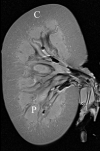Functional and Morphological Changes Associated with Burst Wave Lithotripsy-Treated Pig Kidneys
- PMID: 35920117
- PMCID: PMC9718432
- DOI: 10.1089/end.2022.0295
Functional and Morphological Changes Associated with Burst Wave Lithotripsy-Treated Pig Kidneys
Abstract
Purpose: Burst wave lithotripsy (BWL) is a new technique for comminution of urinary stones. This technology is noninvasive, has a low positive pressure magnitude, and is thought to produce minor amounts of renal injury. However, little is known about the functional changes related to BWL treatment. In this study, we sought to determine if clinical BWL exposure produces a functional or morphological change in the kidney. Materials and Methods: Twelve female pigs were prepared for renal clearance assessment and served as either sham time controls (6) or were treated with BWL (6). In the treated group, 1 kidney in each pig was exposed to 18,000 pulses at 10 pulses/s with 20 cycles/pulse. Pressure levels related to each pulse were 12 and -7 MPa. Inulin (glomerular filtration rate, GFR) and para-aminohippuric acid (effective renal plasma flow, eRPF) clearance was measured before and 1 hour after treatment. Lesion size analysis was performed to assess the volume of hemorrhagic tissue injury created by each treatment (% FRV). Results: No visible gross hematuria was observed in any of the collected urine samples of the treated kidneys. BWL exposure also did not lead to a change in GFR or eRPF after treatment, nor did it cause a measurable amount of hemorrhage in the tissue. Conclusion: Using the clinical treatment parameters employed in this study, BWL did not cause an acute change in renal function or a hemorrhagic lesion.
Keywords: glomerular filtration rate; renal blood flow; renal pathology; ultrasound.
Conflict of interest statement
No competing financial interests exist.
Figures






Similar articles
-
Detection and Evaluation of Renal Injury in Burst Wave Lithotripsy Using Ultrasound and Magnetic Resonance Imaging.J Endourol. 2017 Aug;31(8):786-792. doi: 10.1089/end.2017.0202. Epub 2017 Jun 16. J Endourol. 2017. PMID: 28521550 Free PMC article.
-
Comparison of tissue injury from focused ultrasonic propulsion of kidney stones versus extracorporeal shock wave lithotripsy.J Urol. 2014 Jan;191(1):235-41. doi: 10.1016/j.juro.2013.07.087. Epub 2013 Aug 2. J Urol. 2014. PMID: 23917165 Free PMC article.
-
Kidney damage and renal functional changes are minimized by waveform control that suppresses cavitation in shock wave lithotripsy.J Urol. 2002 Oct;168(4 Pt 1):1556-62. doi: 10.1016/S0022-5347(05)64520-X. J Urol. 2002. PMID: 12352457
-
Factors Affecting Tissue Cavitation during Burst Wave Lithotripsy.Ultrasound Med Biol. 2021 Aug;47(8):2286-2295. doi: 10.1016/j.ultrasmedbio.2021.04.021. Epub 2021 May 31. Ultrasound Med Biol. 2021. PMID: 34078545 Free PMC article.
-
Dual-head lithotripsy in synchronous mode: acute effect on renal function and morphology in the pig.BJU Int. 2007 May;99(5):1134-42. doi: 10.1111/j.1464-410X.2006.06736.x. Epub 2007 Feb 19. BJU Int. 2007. PMID: 17309558 Free PMC article.
Cited by
-
Burst wave lithotripsy - a paradigm shift: inferences from a scoping review.World J Urol. 2025 Apr 25;43(1):250. doi: 10.1007/s00345-025-05645-x. World J Urol. 2025. PMID: 40278907 Free PMC article.
-
Overview of Therapeutic Ultrasound Applications and Safety Considerations: 2024 Update.J Ultrasound Med. 2025 Mar;44(3):381-433. doi: 10.1002/jum.16611. Epub 2024 Nov 11. J Ultrasound Med. 2025. PMID: 39526313 Free PMC article. Review.
References
MeSH terms
Grants and funding
LinkOut - more resources
Full Text Sources

